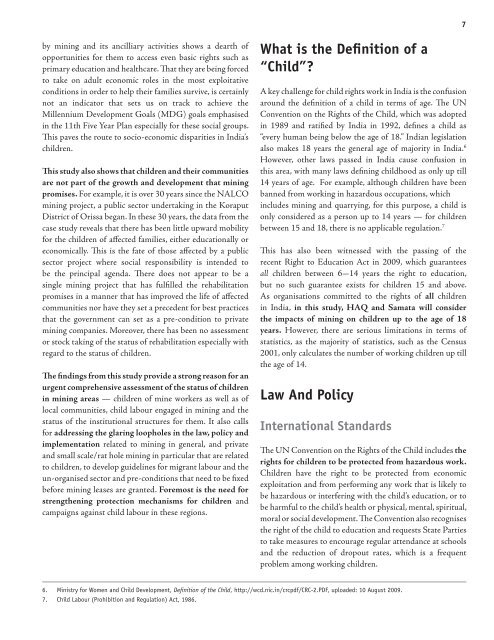Children - Terre des Hommes
Children - Terre des Hommes
Children - Terre des Hommes
You also want an ePaper? Increase the reach of your titles
YUMPU automatically turns print PDFs into web optimized ePapers that Google loves.
7<br />
by mining and its ancilliary activities shows a dearth of<br />
opportunities for them to access even basic rights such as<br />
primary education and healthcare. That they are being forced<br />
to take on adult economic roles in the most exploitative<br />
conditions in order to help their families survive, is certainly<br />
not an indicator that sets us on track to achieve the<br />
Millennium Development Goals (MDG) goals emphasised<br />
in the 11th Five Year Plan especially for these social groups.<br />
This paves the route to socio-economic disparities in India’s<br />
children.<br />
This study also shows that children and their communities<br />
are not part of the growth and development that mining<br />
promises. For example, it is over 30 years since the NALCO<br />
mining project, a public sector undertaking in the Koraput<br />
District of Orissa began. In these 30 years, the data from the<br />
case study reveals that there has been little upward mobility<br />
for the children of affected families, either educationally or<br />
economically. This is the fate of those affected by a public<br />
sector project where social responsibility is intended to<br />
be the principal agenda. There does not appear to be a<br />
single mining project that has fulfilled the rehabilitation<br />
promises in a manner that has improved the life of affected<br />
communities nor have they set a precedent for best practices<br />
that the government can set as a pre-condition to private<br />
mining companies. Moreover, there has been no assessment<br />
or stock taking of the status of rehabilitation especially with<br />
regard to the status of children.<br />
The findings from this study provide a strong reason for an<br />
urgent comprehensive assessment of the status of children<br />
in mining areas — children of mine workers as well as of<br />
local communities, child labour engaged in mining and the<br />
status of the institutional structures for them. It also calls<br />
for addressing the glaring loopholes in the law, policy and<br />
implementation related to mining in general, and private<br />
and small scale/rat hole mining in particular that are related<br />
to children, to develop guidelines for migrant labour and the<br />
un-organised sector and pre-conditions that need to be fixed<br />
before mining leases are granted. Foremost is the need for<br />
strengthening protection mechanisms for children and<br />
campaigns against child labour in these regions.<br />
What is the Definition of a<br />
“Child”?<br />
A key challenge for child rights work in India is the confusion<br />
around the definition of a child in terms of age. The UN<br />
Convention on the Rights of the Child, which was adopted<br />
<br />
“every human being below the age of 18.” Indian legislation<br />
also makes 18 years the general age of majority in India. <br />
However, other laws passed in India cause confusion in<br />
this area, with many laws defining childhood as only up till<br />
<br />
banned from working in hazardous occupations, which<br />
inclu<strong>des</strong> mining and quarrying, for this purpose, a child is<br />
<br />
between 15 and 18, there is no applicable regulation. <br />
This has also been witnessed with the passing of the<br />
<br />
all <br />
but no such guarantee exists for children 15 and above.<br />
As organisations committed to the rights of all children<br />
in India, in this study, HAQ and Samata will consider<br />
the impacts of mining on children up to the age of 18<br />
years. However, there are serious limitations in terms of<br />
statistics, as the majority of statistics, such as the Census<br />
2001, only calculates the number of working children up till<br />
<br />
Law And Policy<br />
International Standards<br />
The UN Convention on the Rights of the Child inclu<strong>des</strong> the<br />
rights for children to be protected from hazardous work.<br />
<strong>Children</strong> have the right to be protected from economic<br />
exploitation and from performing any work that is likely to<br />
be hazardous or interfering with the child’s education, or to<br />
be harmful to the child’s health or physical, mental, spiritual,<br />
moral or social development. The Convention also recognises<br />
the right of the child to education and requests State Parties<br />
to take measures to encourage regular attendance at schools<br />
and the reduction of dropout rates, which is a frequent<br />
problem among working children.<br />
6. Ministry for Women and Child Development, Definition of the Child, http://wcd.nic.in/crcpdf/CRC-2.PDF, uploaded: 10 August 2009.<br />
7.<br />
Child Labour (Prohibition and Regulation) Act, 1986.






